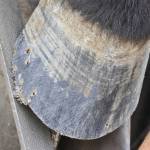The Natural Horse Hoof: Exactly What Is It?

A popular theory states that the hooves of feral horses should be a model for the length and shape of hooves on domestic performance horses. The logic behind the theory says that the hooves of feral horses wear into a perfect natural shape as the horse moves through its environment, exercising and seeking forage.
A study conducted through the School of Veterinary Science at the University of Queensland in Australia has shown that this theory is too simplistic. Researchers evaluated the hooves of several hundred feral horses in a range of environments from sandy deserts to cold alpine regions. Hoof wear varied considerably, with desert horses having significantly shorter hooves than those living on less abrasive surfaces. Horses that lived on softer footing had longer hooves with the characteristic flaring seen in untrimmed feet. Average distance traveled to obtain water also impacted hoof length.
As one part of the four-year study, examination of 100 left front hooves was conducted. Within this sample, 377 gross abnormalities were found, suggesting that feral horses are not immune to the same types of problems that plague domestic horses. Microscopic hoof analysis in three groups of horses showed the incidence of chronic laminitis ranged from 40 to 93%.
This study indicates the shape and length of the natural hoof vary due to environmental factors and the distance between food and water sources. Brian Hampson, Ph.D., leader of the study, said, “The practice of using the ‘natural’ foot model as the optimal morphometric model on which to base foot trimming practices may need to be reconsidered carefully.”








